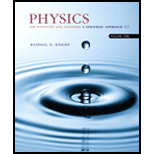
Concept explainers
Figure 13.17 showed a graph of log T versus log r for the planetary data given in Table 13.2. Such a graph is called a log-log graph. The scales in Figure 13.17 are logarithmic, not linear, meaning that each division along the axis corresponds to a factor of 10 increase in the value. Strictly speaking, the “correct” labels on the y-axis should be 7,8.9, and 10 because these are the logarithms of
107....,1010.
a. Consider two quantities u and v that are related by the expression
Vp= Cuqwhere C is a constant. The exponents p and q are not necessarily integers. Define x = log u and y = log v. Find an expression for y in terms of x.
b. What shape will a graph of y versus x have? Explain.
c. What slope will a graph of y versus x have? Explain.
d. Use the experimentally determined “best-fit” line in Figure 13.17 to find the mass of the sun.
Want to see the full answer?
Check out a sample textbook solution
Chapter 13 Solutions
Physics for Scientists and Engineers: A Strategic Approach, Vol. 1 (Chs 1-21) (4th Edition)
- For about 10 years after the French Revolution, the French government attempted to base measures of time on multiples of ten: One week consisted of 10 days, one day consisted of 10 hours, one hour consisted of 100 minutes, and one minute consisted of 100 seconds.What are the ratios of (a) the French decimal week to the standard week and (b) the French decimal second to the standard second?arrow_forwardThe area of a circle is given by ar? where r is the radius. This can be written as area = (ar) x r. Can we regard this equation as being of the form: z = xy 1 PHY1509 PHYSICS SECTION: UNIQUE NUMBER (714489) where z = area, x = ar and y = r so that one can use equation (10.12) or (10.13) instead of equation (10.15) for determining the error in the area? Give reasons for your answer.arrow_forwardFour astronauts are in a spherical space station. (a) If, as is typical, each of them breathes about 500 cm3 of air with each breath, approximately what volume of air (in cubic meters) do these astronauts breathe in a year? (b) What would the diameter (in meters) of the space station have to be to contain all this air?arrow_forward
- One year on Mars is as long as 1.88 years on earth. How many seconds is a Martian year? Please give the correct answerarrow_forwardEarth is approximately a sphere of radius 6.37 * 106 m.What are (a) its circumference in kilometers, (b) its surface area insquare kilometers, and (c) its volume in cubic kilometers?arrow_forwardChapter 5, Section 5.8, Question 32 Determine the length of a rectangular trench you can dig with the energy gained from eating one Milky Way bar (270 cal). Assume that you convert the energy gained from the food with 5% efficiency and that the trench is 7 meters wide and 1 meter deep. Use the fact that the density of soil is 1000 kg/m³ and the acceleration due to gravity is 9.81 m/s². Round your answer to two decimal places. The length of the trench is the tolerance is +/- 2% Click if you would like to Show Work for this question: Open Show Work LINK TO TEXT meters.arrow_forward
- for this problem the average distance of the earth from the sun is about 1.5×10^8kmarrow_forwardFour astronauts are in a spherical space station. If, as is typical, each of them breathes about 500 cm3 of air with each breath, approximately what volume of air (in cubic meters) do these astronauts breathe in a year?arrow_forwardUse Kepler's Law, which states that the square of the time, T, required for a planet to orbit the Sun varies directly with the cube of the mean distance, a, that the planet is from the Sun.Using Earth's time of 1 year and a mean distance of 93 million miles, the equation relating T (in years) and a (in million miles) is 804375T2=a3.Use that relation equation to determine the time required for a planet with mean distance of 206 million miles to orbit the Sun. Round to 2 decimal places. yearsarrow_forward
- Astronomers use the distance modulus function M(r) = 5 log r − 5, where M is the distance modulus and r is the distance of a star from Earth in parsecs. (One parsec is approximately 1.92 1013 miles, or approximately 20 trillion miles.) Use this function to answer the question below. Round to the nearest tenth.The distance modulus of "Star Alpha" is −1.21. How many parsecs from Earth is this star?arrow_forwardEarth is approximately a sphere of radius 6.37 × 106 m. What are (a) its circumference, (b) its surface area, and (c) its volume?arrow_forwardThe average radius of Earth is typically accepted to be approximately 6371 km. Using this dimension, determine the surface area in km2 and the volume in km3. Give both answers in scientific notation to one decimal place.arrow_forward
 Principles of Physics: A Calculus-Based TextPhysicsISBN:9781133104261Author:Raymond A. Serway, John W. JewettPublisher:Cengage Learning
Principles of Physics: A Calculus-Based TextPhysicsISBN:9781133104261Author:Raymond A. Serway, John W. JewettPublisher:Cengage Learning
